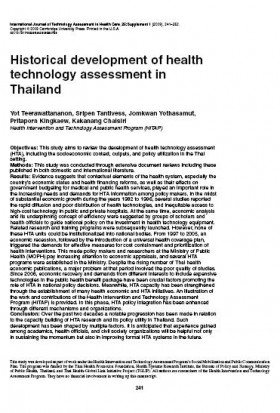This website uses cookies so that we can provide you with the best user experience possible. Cookie information is stored in your browser and performs functions such as recognising you when you return to our website and helping our team to understand which sections of the website you find most interesting and useful.
Historical development of health technology assessment in Thailand. (2009)

รายละเอียดเพิ่มเติม
Historical development of health technology assessment in Thailand
Teerawattananon Y*, Tantivess S*, Yothasamut J*, Kingkaew P *, Chaisiri K*.
*Health Intervention and Technology Assessment Program, Thailand
Objectives
This study aims to review the development of health technology assessment (HTA), including the socioeconomic context, outputs, and policy utilization in the Thai setting.
Methods
This study was conducted through extensive document reviews including these published in both domestic and international literature.
Results
Evidence suggests that contextual elements of the health system, especially the country’s economic status and health financing reforms, as well as their effects on government budgeting for medical and public health services, played an important role in the increasing needs and demands for HTA information among policy makers. In the midst of substantial economic growth during the years 1982 to 1996, several studies reported the rapid diffusion and poor distribution of health technologies, and inequitable access to high-cost technology in public and private hospitals. At the same time, economic analysis and its underpinning concept of efficiency were suggested by groups of scholars and health officials to guide national policy on the investment in health technology equipment. Related research and training programs were subsequently launched. However, none of these HTA units could be institutionalized into national bodies. From 1997 to 2005, an economic recession, followed by the introduction of a universal health coverage plan, triggered the demands for effective measures for cost containment and prioritization of health interventions. This made policy makers and researchers at the Ministry of Public Health (MOPH) pay increasing attention to economic appraisals, and several HTA programs were established in the Ministry. Despite the rising number of Thai health economic publications, a major problem at that period involved the poor quality of studies. Since 2006, economic recovery and demands from different interests to include expensive technologies in the public health benefit package have been crucial factors promoting the role of HTA in national policy decisions. Meanwhile, HTA capacity has been strengthened through the establishment of many health economic and HTA initiatives. An illustration of the work and contributions of the Health Intervention and Technology Assessment Program (HITAP) is provided. In this phase, HTA policy integration has been enhanced through different mechanisms and organizations.
Conclusion
Over the past two decades a notable progression has been made in relation to the capacity building of HTA research and its policy utility in Thailand. Such development has been shaped by multiple factors. It is anticipated that experience gained among academics, health officials, and civil society organizations will be helpful not only in sustaining the momentum but also in improving formal HTA systems in the future.
Link :




